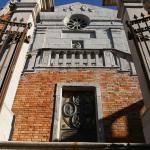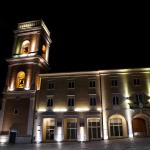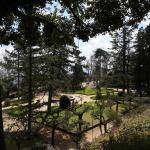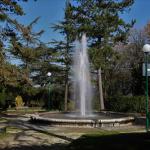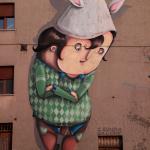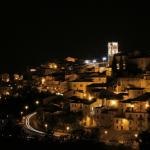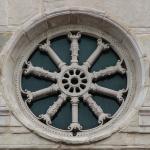The town of Ariano Irpino is located on the northern side of the Ufita Valley, 601 metres above sea level and 76 km from Avellino. With its 22,004 inhabitants and its 100.88 sq km, it is the second most populous municipality in the province of Avellino, as well as the largest by area. The neighbouring municipalities are: Apice, Castelfranco in Miscano, Flumeri, Greci, Grottaminarda, Melito Irpino, Montecalvo Irpino, Monteleone di Puglia, Savignano Irpino, Villanova del Battista and Zungoli. The Ufita and Miscano rivers run through it and it is crossed by the Cervaro stream.
The etymology of the name could derive from the Latin term Ab Ara Iani, with reference to an ancient pagan altar dedicated to the god Janus or, according to another version, from the phrase Fundus Arianus (lit. “land of Arius”). The inhabitants are called Arianesi and Saint Ottone Frangipane is their patron saint.
PLACES OF INTEREST
- Norman Castle - Of Lombard origin, later restored and enlarged by the Normans, it stands on the summit of the hill of the same name
- Cathedral - The imposing basilica is dedicated to the Assumption of Mary, to Saint Ottone Frangipane (protector of the diocese) and to Saint Elzearo of Sabrano (co-patron saints)
- Museum of Ceramics - The ancient Forte Palace houses over 250 ceramics to tell the story of an ancient art that mixes water, fire, earth and air with the colours and mastery of Ariano potters
- Museum of Norman Civilisation - Located in the Norman Castle, it preserves the numismatic collection, a large model of the Battle of Hastings in 1066 and about 200 authentic specimens of weapons from various eras
- Museums - Archaeological Museum, Diocesan Museum, Museum of the Cathedral’s Silver Collection, “Giuseppina Arcucci” Museum, Museum of the History of the Earth and Life
- Sanctuary of San Liberatore Vescovo e Martire (Saint Liberatore Bishop and Martyr) - Located on a hill surrounded by olive groves, it is dedicated to the co-patron Saint Liberatore
- Sanctuary Salus Infirmorum of Valleluogo - Located at a historic mill, in a valley rich in water and ancient trees
- Church of San Pietro Apostolo della Guardia (Saint Peter the Apostle of Guardia)- It is located in the historic Guardia district and dates back to 1459
- Church of the Madonna del Carmine (Our Lady of Mount Carmel) - Built in 1688, near the former Capuchin convent
- Church of Sant’Agostino (Saint Augustin) - Located in the ancient Piazza Ferrara, it houses an altar of the Consolation of the 16th century
- Municipal Villa - Built in 1876 in the Castle area, it stands out for its vast panoramic views
- Palaces - ex Bevere-Gambacorta Palace, San Giacomo Palace, Anzani Palace, Forte Palace, Vitoli-Cozzo Palace, De Piano-D’Afflitto Palace, Marino Palace, ex Vitale-Pisapia Palace, Sgobbo Mansion, Forte Mansion
- Towers of the territory - In the north-east sector of the municipal countryside, there are three watchtowers from the Middle Ages: the Torre delle Ciaule, the Torretta di Camporeale, and the Torre delli Pizzi
- Historical paths and ancient roads - Regio Tratturo (old transhumance route) Pescasseroli-Candela, Via Francigena del Sud, Via Traiana, Via Aemilia, Via Herculea, Mulattiera Regia Angioina, Country routes of the High Middle Ages and Modern era
- Nature trails - Nature Trail “Among the historic olive groves”, Path “On the wheat roads”, River paths (Cervaro, Miscano, streams and natural rivulets that descend from the slopes of the territory)
- Other - Archaeological sites (Prehistoric archaeological site of Starza, Preclassical-classical and medieval archaeological site of Aequum Tuticum-S. Eleuterio), Libraries and archives (Municipal Library P. S. Mancini, Diocesan Library, Library of the Municipal Museum, Library of the European Centre for Norman Studies, Municipal Archive, Diocesan Historical Archive, Parish Archives), Churches (Church of Sant'Angelo, Church and Conservatory of San Francesco Saverio, Church of Saint Anne and Pia Casa di Istruzione e Lavoro (Holy House of Learning and Work), Church of San Vincenzo Pallotti (Saint Vincent), Church of San Giovanni Battista della Valle (John the Baptist of the Valley), Church of San Pietro “de reclusis”, Church of Santa Maria dei Martiri (Holy Mother of Martyrs), Church of Santa Maria di Loreto (Our Lady of Loreto), Church of Santa Barbara, Church of San G. Evangelista (John the Evangelist), Church of San Giuseppe (Saint Joseph), Church of Santa Maria del Buon Consiglio (Our Lady of Good Counsel), Church of Santa Maria delle Grazie (Saint Mary of Graces), Church of Santa Teresa del Bambin Gesù (Saint Teresa of Lisieux), Church of Santa Maria Assunta-Manna (Saint Mary of the Assumption), Sanctuary of the Madonna di Fatima (Our Lady of Fatima)), Borgo dei Tranesi, Ancient Oil Mills (Trappeto Guardabascio, Trappeto di Maina), Ancient Mills (in Valleluogo), Ancient Farmhouses (Falceta, Serro, Chiuppo dè Bruno, S. Eleuterio), Fountains (Maddalena, Tetta, S. Antonio, Scarnecchia, S. Barbara, Brecceto), Boschetto dei Pasteni woods
EVENTS
- Ariano Folkfestival - Music festival that hosts the major exponents of world, folk and gypsy music from all over the world, held in August
- Historical Re-enactment of the Gift of the Sacred Thorns - Three days of medieval setting, re-enacting the moment when Charles I of Anjou donated two Sacred Thorns of the crown of Christ to the survivors of the massacre carried out by the Saracens in 1255, held in August
- Vicoli e Arte (Alleys and Art) - Cultural event held in August, born with the aim of making known and enhancing the historical stratification present in the alleys, houses and caves of the historic Arianesi districts
- Ariano International Film Festival - Film festival that takes place between the end of July and the beginning of August
- Pizza Festival - Food and wine event, held in August
- Feast of Saint Anthony - Celebrations in honour of Saint Anthony of Padua, held in June
- Mediterranean Taste Fair - International event on food and wine, held in October in the Fiere della Campania exhibition centre
- Sud Motor Expo - Event dedicated to the world of engines, held in September in the Fiere della Campania exhibition centre
TYPICAL FOOD AND PRODUCTS
- Irpinia Colline dell’Ufita PDO - Extra virgin olive oil deriving largely from the Ravece variety, characterised by a pleasant bitter and spicy taste
- Caciocavallo Silano PDO - Semi-hard cheese, with spun curd, produced with milk from different breeds of cows, including Podolica
- Ufita garlic PAT - Product with an aromatic flavour and characterised by a high amount of essential oils and active agents
- Caciocchiato PAT - Semi-hard cheese, with spun curd, oval in shape, produced with milk from mixed-breed cows, with medium ageing (from 2 to 6-12 months) in rooms at a controlled temperature
- Melella Cherry PAT - White, with firm pulp and very compact
- San Pasquale Cherry PAT - Red, medium-sized, usually eaten fresh
- San Giovanni PAT Apple - Apple with a greenish-yellow skin, characterised by a very fragrant, crunchy and juicy pulp
- Sant’Anna Pear PAT - Fruit with a delicious sugary taste, yellow in colour, has small red spots in the parts most exposed to the sun
- Spina Pear PAT - Similar to the Sant’Anna, it is distinguished from it by its smaller size
- Risciola PAT - Precious ancient wheat, rich in minerals and vitamins that ensure a strong and authentic taste
- Casatiello - Calzone stuffed with ricotta, sometimes also sweetened, prepared especially during the Easter period
- Laine and Ciciri - Fresh pasta rolled to a sheet, seasoned with chickpeas and tomato sauce
- Minestra Maritata - Dish with a pork and boiled vegetable base
- Pipilli Chini - Round peppers stuffed with bread crumbs, pine nuts, raisins, oil and cooked wine
FUN FACTS
The city centre of Ariano Irpino rises in a dominant position on three hills (Castello, Calvario and San Bartolomeo), from which the epithet of Città del Tricolle (City of the three hills) is derived.
From 1868 to 1930 the city took the name of Ariano di Puglia and was the seat of the district of the same name, existing until 1926.
The municipal stadium located in Via della Ginestra is named after the Olympic track and field champion Pietro Mennea (1952-2013).
HISTORICAL NOTES
The origins of Ariano Irpino date back to the Neolithic settlement of Starza, located along the road that leads from Benevento to Foggia. The Samnites later founded in the area of Sant’Eleuterio Aequum Tuticum (“field” or “great plain”). With the passage of time, this site was Romanised and became an important road junction along the route of the Tratturo (old transhumance route) “Candela-Pescasseroli”.
With the Barbarian invasions, however, the decadence of this settlement called Aequum Tuticum began, until it disappeared due to violent earthquakes.
Subsequently, the inhabitants began to settle on a different area, the Tricolle, on a hill to the south. This is how Ariano Irpino was born, a Lombard stronghold that, during the various eras, saw the alternation of various conquering peoples, including the Normans, supporters of the restructuring of the Castle. To own the fief were then the Swabians, the Angevins, the Provencal family of Desabramo, the Carafa and Gonzaga families, until in 1585 the city redeemed itself from the feudal regime to become a Royal City.
What to do in Ariano Irpino? There are many possible choices to share with the family, from the Norman Castle, one of the best preserved fortresses, whose stories always fascinate young and old, to the Ariano Folk Festival, a true ethnocultural project that through music reinvents human relationships in the name of inclusion and dialogue between cultures
Ariano Irpino
Piazza Plebiscito, 1, 83031 Ariano Irpino AV, Italia
Events
Saturday 13 January music, puppets, the great shower of bubbles and the little ones' favorite…
-
Food and wine markets, art exhibitions, street artists, musicals and concerts, children's…
On Thursday 18 January the greatest contemporary Italian violist, accompanied by the pianist…
Saturday 4th January tradition, good music with the extraordinary participation of Francesco…
-
Saturday 20th and Sunday 21st January, second show by the SulReale Company. A sequence of…
-
Friday 3, Saturday 4 and Sunday 5 January popular music and tarantellas, vintage and artisan…
Featured places
Via Castello, 83031 Ariano Irpino AV, Italia
A rich testimony to one of the oldest counties in Italy, the Museum of Norman Civilisation in…
Via Castello, 83031, Ariano Irpino AV, Italia
A significant example of the presence of northern populations in Irpinia, known for its…
Piazza Duomo, 3, 83031, Ariano Irpino AV, Italia
One of the richest religious and artistic places of worship in the entire province, Ariano…
Palazzo Forte, Via R. D'Afflitto, 7, 83031 Ariano Irpino AV, Italia
Located in the heart of the historic centre, the Civic and Ceramic Museum of Ariano Irpino…
Did you like it? Leave a review
Your opinion is important! It will be visible after approval by the editorial staff.
To post a comment you must be an authenticated user. Log in with Social Login
